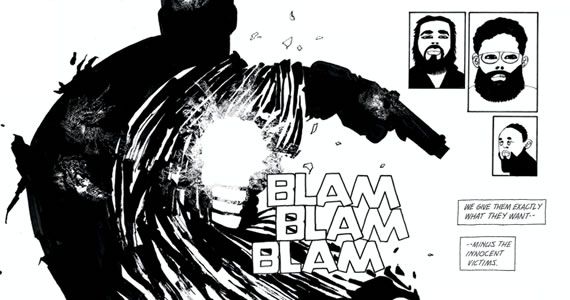There's no way to get around it: Even in its reworked form, Holy Terror is a goddamn Batman story. Frank Miller's long-awaited superhero vs. terrorist graphic novel finally emerges this week, and it's everything you'd think it would be ... including "visually impressive," "disturbingly simplistic" and, to be honest, proof that terrorism seems to have worked in Miller's case.
Oddly enough, for a book that starts out as an almost comically obvious reworking of Batman pages -- there's no way to avoid groaning at how phoned-in Miller's revisions are to the beginning of the book -- Holy Terror ends up feeling less like a Batman book than the work of someone who was profoundly affected by the events of September 11th, to the point where fear took over from whatever artistic drive used to push Miller's work. This isn't a story as much as a revenge fantasy from someone who is clearly terrified of the world that he's found himself living in, and closed himself off from reality as a result; not only are the terrorist villains of the book ridiculously simplistic, but so is the "war" that the Fixer carries out against them. The terrorist characters that appear fulfill almost every single stereotype imaginable about them, including an apparent ability to be wherever they need to be to destroy a helicopter just because the plot demands it, and because it makes the "enemy" more unknowable and scary, and yet they can easily be defeated with guns and bombs, because, you know, more violence is always the answer.
It's a willfully stupid book, I think; pitched as a mix of parody and propaganda -- something that could be used to describe most of Miller's superhero work, arguably -- there's a sense that it's so painfully unfunny because the jokes are all old and weren't that good to begin with. With the exception of a genuinely beautifully illustrated, kinetic opening sequence (ignore the dialogue, admittedly), the book feels almost unfailingly tired and desperate, as if trying to convince itself of its own relevance as much as the reader, and failing throughout. Everything in here feels dated, cliched in the worst possible ways ("Not all of us around here have a problem with english, my curvy young infidel," says the leader of the terrorist cell, while "Natalie Stark," Catwoman-in-all-but-name, kneels in bondage at the forefront of the panel, trussed up in rope that, of course, emphasizes her breasts) and profoundly unnecessary. Even more so than Miller's other work, the writing here is reductive to the point of offensiveness -- David Brothers makes a great point here about Miller's mistaking faith for jihad -- and the entire book reads like the fantasy of an old man who wishes things were easy like the stories of earlier wars that he grew up on, refusing to complicate his world view with nuance or facts.
There's little to recommend this, beyond Miller's name recognition. It's easy to imagine DC Comics' editorial recoiling in horror upon reading whatever he'd completed back when he wanted it to be a Batman book, and it's depressing to see it become the first book from Legendary Comics, if only because it really is just a crappy comic, even if you ignore the problematic propaganda and politics behind it (The art is completely uneven, going from spectacular to scratchy, simply-inked angular work that looks like it's come from a different artist altogether; the dialogue never reaches above sub-noir cliche, the plot mechanics are laughable). As a comic that's likely to get a lot of attention outside the comic press purely because of Miller's involvement, this is an ugly advertisement for the worst comics has to offer, and an embarrassment all round.

